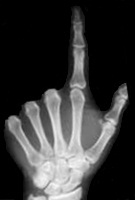Journal Club
September 2010
Surgical hand antisepsis to reduce surgical site infection
- Authors: Tanner J, Swarbrook S, Stuart J.
- Institution:De Montfort University and University Hospitals Leicester, Leicester, UK
- Journal: Cochrane Database Syst Rev. 2008 Jan 23;(1):CD004288.
Reviewed by
Dr Josh Petterwood
MBBS | Accredited Orthopaedic Registrar
Introduction
- Cochrane Review 2008
- Objectives
- To determine the effects of surgical hand antisepsis on
- Surgical site infections (SSIs)
- Number of colony forming units (CFUs) of bacteria on the hands of the surgical team
Methodology
- Inclusion criteria
- Published/unpublished RCTs
- Type of intervention
- Surgical hand antisepsis
- Aqueous scrub solutions
- Alcohol rubs
- Alcohol rubs containing additional active ingredients
- Surgical hand antisepsis of different durations
- Surgical hand antisepsis with different equipment
- Surgical hand antisepsis
- Outcome measures
- Primary
- SSIs
- SSIs
- Secondary
- CFUs of bacteria on hands
- Primary
- Electronic searches
- Cochrane Wounds Group Specialised Register
- CENTRAL
- Ovid MEDLINE
- Ovid EMBASE
- Ovid CINAHL
- ZETOC database of conference proceedings
- Cochrane Wounds Group Specialised Register
- 3 authors independently assessed papers
- Data extraction according to standardised form – by two authors independently and cross checked by third
- Assessment of risk of bias
- Adequacy of randomisation
- Adequacy of concealment
- Blinding
- Intention to treat analysis
- Completeness of follow up
- Pre-trial sample size calculations
- Use of clear inclusion/exclusion criteria
- Adequacy of randomisation
- Data synthesis
- Continuous outcomes – CFUs – weighted mean differences and 95% CI
- Dichotomous outcomes – SSIs – RR and 95% CI
- No metaanalyses due to heterogeneity of studies
- Continuous outcomes – CFUs – weighted mean differences and 95% CI
Results
- 10 studies included
- 1 only reported on SSIs
- 9 reporting on CFUs
- Four trials – relative effects of different types of aqueous scrubs
- Two trials – relative effects of alcohol rubs with additional active ingredients
- Six trials – compared aqueous scrub with alcohol rub with additional active ingredients
- Four trials – duration of scrub
- No trials – antisepsis vs no antisepsis
- No trials – comparing alcohol only rubs
- No trials – brushes, sponges etc
- Four trials – relative effects of different types of aqueous scrubs
- Study details
- 2 Australia, 2 US, 2 Germany, France, Spain, Japan, UK
- 5 studies - participants took part in surgical procedures
- Range of specialties
- 5 trials only provided detailed description of the antisepsis technique
- 2 Australia, 2 US, 2 Germany, France, Spain, Japan, UK
- Outcome measures
- SSIs (Parienti JAMA 2002)
- 30 day follow up
- SSI according to CDC guidelines
- Confirmed by surgeon
- 30 day follow up
- SSIs (Parienti JAMA 2002)
- CFUs (9 studies)
- 2 finger press method
- 7 glove juice method (FDA considered 'gold standard')
- 2 finger press method
- Aqueous scrubs vs alcohol rubs containing additional active ingredients
- 5 studies
- No meta analysis possible
- 4 used CFUs as primary outcome measure
- 2 rub significantly better
- 1 rub significantly worse
- 4 participants only
- Finger press method
- 4 participants only
- 1 equivocal
- Insufficient raw data for independent analysis
- Insufficient raw data for independent analysis
- 2 rub significantly better
- Parienti JAMA 2002
- Multi center in France 2000-01
- French Government funding
- Randomised equivalence trial – pre-trial power calculation performed
- 4387 consecutive patients undergoing clean or clean-contaminated surgery
- Intervention
- Hand rub with 75% aqueous alcoholic solution containing pro- panol-1, propanol-2, and mecetronium etilsulfate
- Scrub with antiseptic preparation containing 4% povidone iodine or 4% chlorhexidine gluconate
- Hand rub with 75% aqueous alcoholic solution containing pro- panol-1, propanol-2, and mecetronium etilsulfate
- Outcome measure
- SSIs in first 30 days
- CDC definition – confirmed by surgeon
- Secondary
- Compliance/tolerance
- Compliance/tolerance
- Method
- Cluster, crossover
- Intervention changed at each service each month for 15 months
- Cluster, crossover
- SSIs in first 30 days
- Results
- Scrub
- 53/2135 SSIs (2.48%)
- 53/2135 SSIs (2.48%)
- Rub
- 55/2252 (2.44%)
- 55/2252 (2.44%)
- Significantly better compliance and tolerance in rub group
- Scrub
- Multi center in France 2000-01
- Chlorhexidine vs povidone iodine aqueous scrub
- 4 studies
- Pooling not possible
- Chlorhexidine significantly fewer CFUs
- 4 studies
- Comparison of different alcohol rubs containing additional active ingredients
- 2 trials
- 1 compared chlorhexidine plus different alcohols
- 1 compared alcohol plus chlorhexidine or zinc pyrithione
- No difference between alcohol rubs
- 2 trials
- Duration of antisepsis
- 4 trials
- 2 min vs 3 min scrub
- 5 min rub vs 3 min rub
- 5 min/3min scrubs vs 3 min/30 sec scrub with chlorhexidine
- 5 min/3min scrubs vs 3 min/30 sec scrub with povidone iodine
- 5 min/3.5 min scrubs vs 3 min/2.5 min scrubs using chlorhexidine
- 2 min vs 3 min scrub
- 3 minute rub is better than 5 minute rub
- No difference in scrub times over 30 seconds
- 4 trials
- No papers
- Comparing antisepsis with no antisepsis
- Comparing alcohol only rubs
- Comparing alcohol only rubs with rubs containing additional active ingredients
- Brushes, sponges et
- Comparing antisepsis with no antisepsis
Discussion
- Hands a potential source for transfer of bacteria
- Glove permeability
- Glove tears/punctures
- Glove permeability
- Surgical site infections
- Common
- 10% UK, 38% US
- 10% UK, 38% US
- Costly
- Potentially devastating
- Common
- Antiseptic agents need to be
- Fast
- Effective
- Persistent
- Cumulative
- Tolerable
- Broad spectrum of activity
- Fast
- Potential benefits of alcohol based rubs
- Compliance
- Better tolerated
- Less time consuming
- Less expensive
- 203 vs 25 euros per week – Girard 1996
- 203 vs 25 euros per week – Girard 1996
- Water saving
- At least equivalence in level of antisepsis
- Compliance
Review Findings
- Chlorhexidine scrub is superior to povidone iodine scrub
- Concentration of alcohol in hand rubs is more important than the type of alcohol
- Safe to use alcohol rub with additional active ingredients as an alternative to the initial and subsequent scrubs
Pros of Study
- well conducted
Cons of Study
- Limitations
- Most papers use surrogate marker
- Colony forming units
- Colony forming units
- Reporting of SSIs is difficult
- Heterogeneity of studies
- Large numbers required
- Particularly for SSIs
- Dichotomous vs continuous variable
- Particularly for SSIs
- Most papers use surrogate marker
Take home message
- One minute wash with non-antiseptic soap followed by application of alcohol based hand rub is equivalent to the traditional scrub in terms of antisepsis and has a number of further benefits
- it should be considered the standard of care
- If you are going to scrub
- Don't use betadine!!!
Webpage Last Modified:
15 September, 2010



